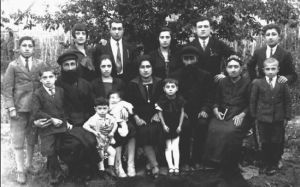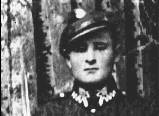| strona główna | cmentarze | warto wiedzieć | księga gości | napisz do nas |
| SŁAWATYCZE | ||
The Jewish settlement in Sławatycze is comparatively old. The first references to Jews living there originates from the first half of the XVII century. Even then Jews had played an essential role in the local economy. Archival records of 1656 state that out of the thirty lots near the market place, twenty-one were properties of Jews. About the late 1,700's there were about 1,945 inhabitants in Sławatycze among whom 1,089 persons were of Jewish origin. That number remained for the next centuries. At the end of the XIX century the authors of the "Słownik geograficzny Królestwa Polskiego i innych krajów słowiańskich " (Geographical Dictionary of the Polish Kingdom and other Slavic Countries) in the section dedicated to Sławatycze mentions that there were 256 houses and 2,388 inhabitants; mostly Jews. |
||
The Rybkowski, Gitelman & Pachter families of Sławatycze, circa 1928. This photo is courtesy of Henry (Chaim-Lejb) Gitelman |
||
Yet, the Jewish population had decreased between the XIX and XX centuries. During the First World War, Cossacks burnt many houses in Sławatycze. Jews, as undesirable elements, were expelled from the town by the retreating Cossacks, but the majority of them later tried to return to Sławatycze. Difficult economic conditions forced many of the inhabitants to emigrate. Henry (Chaim-Lejb) Gitelman, a descendant of Sławatycze recalls these times in the book he is gathering/editing; O h! Slawatycze my home. , the Personal Memories of Descendants of Slawatycze :- "Life in Sławatycze was hard and a great number of the people were poor. The majority of the town inhabitants lived on the border of extreme poverty. It was difficult to find work in our sztetl, so many young people sought work in the bigger cities, especially Warsaw. Many Polish Jews emigrated to England, the USA, Canada, Argentina, Australia and Palestine". Some went on to the other "Jewish Promised Land" the "Jewish Autonomous Region of Birobidzhan" located in Far East of Asiatic Soviet Russia, near the Manchurian border. Due to the economic crisis between the two World Wars, anti-Semitism in Poland increased, and had become even stronger after the death of Marshal Jósef Pilsudski. It is no surprise that the first national census of 1921 in the Polish Republic showed only 902 persons of Jewish origin in Sławatycze. |
||
Herszko Gitelman served in the elite cavalry of the Pierwszy Pułk Ułanów im. Marszałka Józefa Piłsudskiego. This photo is courtesy of Henry (Chaim-Lejb) Gitelman |
||
| Yet, the Jewish population had decreased between the XIX and XX centuries. During the First World War, Cossacks burnt many houses in Sławatycze. Jews, as undesirable elements, were expelled from the town by the retreating Cossacks, but the majority of them later tried to return to Sławatycze. Difficult economic conditions forced many of the inhabitants to emigrate. Henry (Chaim-Lejb) Gitelman, a descendant of Sławatycze recalls these times in the book he is gathering/editing; O h! Slawatycze my home. , the Personal Memories of Descendants of Slawatycze :- "Life in Sławatycze was hard and a great number of the people were poor. The majority of the town inhabitants lived on the border of extreme poverty. It was difficult to find work in our sztetl, so many young people sought work in the bigger cities, especially Warsaw. Many Polish Jews emigrated to England, the USA, Canada, Argentina, Australia and Palestine". Some went on to the other "Jewish Promised Land" the "Jewish Autonomous Region of Birobidzhan" located in Far East of Asiatic Soviet Russia, near the Manchurian border. Due to the economic crisis between the two World Wars, anti-Semitism in Poland increased, and had become even stronger after the death of Marshal Jósef Pilsudski. It is no surprise that the first national census of 1921 in the Polish Republic showed only 902 persons of Jewish origin in Sławatycze. After the outbreak of World War II in September of 1939 confusion erupted in the community which the local Communists tried to control by organizing a "Workers' Guard". Amongst this group there were many young Jews. In the middle of September the Germans occupied the town, but after a few days they withdrew. On September 22, 1939 the Red Army entered Sławatycze. As previously mentioned, Henry Gitelman recalls the Russians' entry to Sławatycze:- "The commanding officer of the Red Army demanded a welcoming delegation with red flags to greet them and lead them into the town. The local rabbi together with the Catholic and the Russian Orthodox priests came out to welcome the invaders in the traditional way - by carrying bread and salt on a tray". Soon after, the Red Army left the town and returned East across the Bug River. By virtue of the of Ribbentrop-Molotov pact, Sławatycze was again occupied by the Germans. German repressions over the local Jewish people began increasing gradually and becoming more and more severe. Soon after the German occupation, the Jewish members of Workers' Guard, that previously controlled the streets of Sławatycze in September, were caught and executed. The following weeks brought more executions; in February 1940 Nazis executed a group of more than 20 persons. Jews were deprived of any civil rights, had to wear arm bands with the Star of David and were forced to do forced labour for the Nazi occupants. Jews from the small villages of Hanna, Dolhobrody and Holeszów were relocated to Sławatycze. Up to May, 1942 the Jewish population in Sławatycze numbered 1,502 persons. The final solution was carried out in 1942 at the end of June. The Nazis ordered all Jews to gather in the market place. Many of them, sensing a cruel fate, tried to escape and hide in the vicinity. The majority did not succeed to escape. During the next three days the German Nazis pulled out hidden Jews and killed them on the spot. It is estimated that between six hundred and one thousand Jews were executed at that time. The victims were buried in a mass grave at the Jewish cemetery. Jewish owned houses were burned. Those Jews who remained alive after this aktion were resettled in a ghetto in the area of Pielwaki street. The ghetto was guarded day and night. At the end of September of 1942 all Jews were forced to gather in the market place. Women and children were placed on commissioned wagons. The men were ordered to take off their shoes and were marched barefooted, four abreast. A long column, guarded by the Germans and the Navy-Blue Polish police left Sławatycze. Witnesses to this tragic march remember that many of the people were killed on the way. After they reached Międzyrzec Podlaski the Sławatycze Jews were deported to the Treblinka concentration camp where they perished in the gas chambers. A handful of Sławatycze Jews survived the war. Among them were Wewe (Welwel) Grynszpan and his son Chaim-Joszke Grynszpan (Henry Greenspan). They were hidden by the Parczewski family who risked their own lives and the lives of their family for helping Jews. After the war, Anna and Dominik Parczewski were recognized by Yad Vashem as Righteous Among the Nations. Also Józef and Marianna Krzymowski from Sławatycze got the same award. After the liberation, Wewe Grynszpan and his son Chaim-Joszke were the only Jews who resettled in their sztetl Sławatycze. One night, in 1945, when Chaim-Joszke was out of town, his father Wewe Grynszpan was treacherously murdered by unknown perpetrators. The Jewish cemetery in Sławatycze is located on Polna street on a plot shaped in the letter "L" of an area of 1.35 hectares, about 100 metres behind the Roman Catholic cemetery. During WWII corpses of Jewish Holocaust victims were buried in mass graves on cemetery grounds. Krzysztof Gruszkowski in his essay "Sławatycki okręg bóżniczy" (The Synagogue District of Sławatycze) describes one of these tragic episodes: "Designated Poles were conscripted to transport the corpses of murdered Jewish men, women and children on horse driven wagons to the local Jewish cemetery and to throw the bodies into a mass grave of about 100 metres long. Among those conscripted for this gruesome task was my father who was then 17 years old. Suddenly, my father heard the voice of a dying Jew who was already thrown into the common grave. He was wailing; " kill me, kill me ". Terrified and not knowing what to do, my father turned to the escorting German soldier who then ordered my father not to stop throwing earth onto the Jews in the mass grave." During and after the War, the Jewish cemetery was desecrated; the tombstones were removed and used as building material. As years passed, the Sławatycze Jewish cemetery was forgotten, neglected and overgrown with weeds. |
||
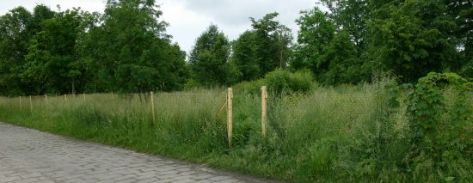 |
||
The Jewish cemetery in Sławatycze before restoration works (photo: A. W±sowicz) |
||
In 2008 the grounds of the Sławatycze Jewish cemetery was cleaned up, the surrounding fence repaired and a new gate was installed. This work was done by FODZ, Fundacja Ochrony Dziedzictwa Żydowskiego (Foundation for the Preservation of Jewish Heritage) with the financial help of Jewish descendants of Sławatycze and the Jewish Community of Warsaw. Young residents of Sławatycze found two matzevahs and returned them to the Jewish cemetery. They also attended the official rededication ceremony which was held on May 19, 2008 at the Jewish Cemetery and the unveiling of a plaque commemorating the Jews of Sławatycze. |
||
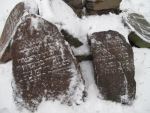 |
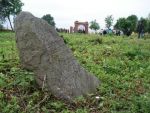 |
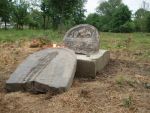 |
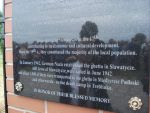 |
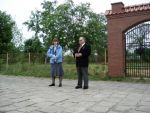 |
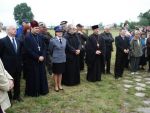 |
The above pictures were taken at the May 19, 2008 rededication ceremony |
||
In the cemetery there are now three fragmented tombstones, one has a carving of a hand pouring a jug of water indicating that it is the matzevah of a Levite. text: K. Bielawski |
||
The author wishes to thank Henry Gitelman for his help |
||
| Read the letter by Karen Greene | ||
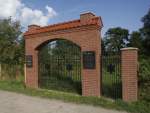 |
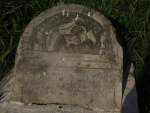 |
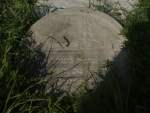 |
photos: Wurkut |
||
We look forward to receiving any information about Sławatycze Jews and their cemetery. We are also awaiting more information from people who remember the cemetery from before World War II. |
||
| The text and pictures are published by the services of www.kirkuty.xip.pl and are the property of the authors. To utilize this material it is necessary to obtain the written permission from the editor. | ||
| strona główna | cmentarze | warto wiedzieć | księga gości | napisz do nas |

